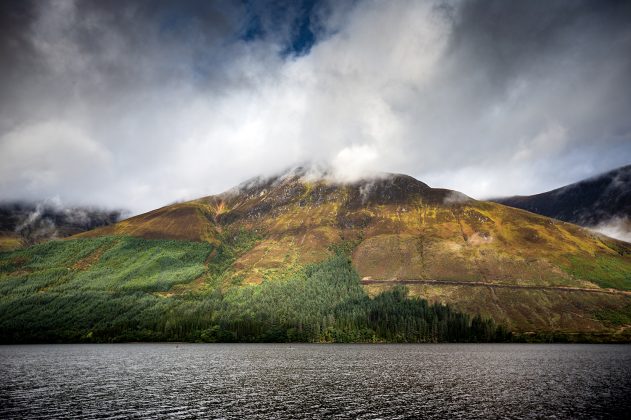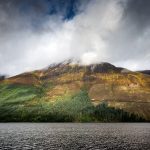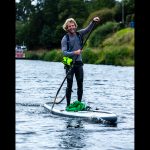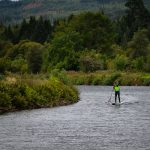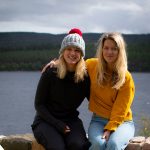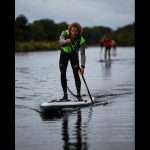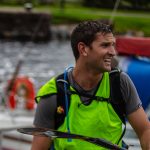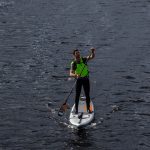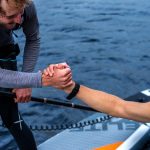GREAT GLEN CHALLENGE
With Jay Haysey & George Shillito // Photos www.globalshots.co.uk / Bethany Mercer
A great shout erupts from the centre of fifty neoprene-clad people clustered on the dark banks of Loch Ness. The wind whips and pulls at the group of paddlers, all of whom are fortified by a dram of whisky, as the sound of Scottish bagpipes signifies the first grey light of dawn. With it, the true scale of Loch Ness stretches out before the challengers, as dark, ferocious gusts claw at the surface of the black water and bands of sleet and rain cut at bare flesh.
Jostling to hold position against the restless elements, the group are battered and blown down the small protected channel at Fort Augustus towards the yawning, open mouth of the 40-kilometre Loch. As they reach its entrance, an airhorn blast, heard only by those in wait, is quickly whipped off downwind as a blur of paddles rip and churn at the water to propel their owners into the ensuing chaos. This was the start of the second day of racing the Great Glen Challenge 2018 and what a day it was set to be! We catch up with Red Paddle Co riders Jay Haysey and George Shillito as they recount their experiences and offer some advice for anyone looking to take on an adventure of their own…
You won 1st and 2nd place in the Great Glen Challenge 2018 for the inflatable SUP class! Can you describe the sense of achievement that statement brings?
JH – I was super surprised as I had no idea I would come first. I thought George would have at least beat me. I think at the time my tiredness overrode all emotion of joy! I was so physically exhausted all I wanted to do was curl up in a ball and go to sleep. The next day and the whole drive back from Scotland however were a really nice time to reflect on what both myself and George had just achieved.
GS – It seems pretty crazy if I’m honest. I entered thinking I’d take it easy, bury my inner competitive-nature and enjoy the incredible scenery along the way. I guess that plan didn’t last long after the moment I stepped on the board at the start! Jay was on another level on the first day, machine-like in fact, I just remember following him thinking over and over again, does he not stop even for a second? Maybe just to eat, drink or generally take it all in? Turns out the answer to that was no!
What drove you to sign yourself up to paddle 92K across the whole of Scotland? Why the Great Glen Challenge?
JH – I initially signed up as I wanted to give myself a new paddle challenge and have something to focus on over the summer other than work. I had competed in the SUP 11 cities twice before and wanted to do an event that was a bit different. I really enjoyed the training over the summer months. I chose the Great Glen specifically as I knew the scenery would be amazing and the conditions could potentially be tricky and challenging. Also, I loved the idea of doing a mega downwind race.
GS – Jay! We had discussed doing the SUP11 Cities several times but were unable to make it so he suggested we sign up to the Great Glen challenge. Having cycled and run the length of the Caledonian Canal (Great Glen) a few years before I had an itch to go back and paddle it. The scenery was simply breath taking and idea of viewing the lochs from the middle rather the edge was a pull that proved too strong, the idea of 92KM never really soaked in until it was too late, and I had firmly booked my spot.
Why did you choose to take on such a distance on an inflatable race board?
JH – I chose an inflatable to give myself more of a challenge, I was also intrigued to put the board to the test as I have only raced on carbon boards before. It turned out to be really handy having an inflatable for training as I could easily put the board in the boot of my girlfriend’s Fiat 500, and even inflated on the roof for which I received many funny looks from the neighbours. Having the board in the boot meant I could pick and choose spots to head out and do a training session depending on where I was. I also drove up to the event in my camper so the board fitted nicely in the back and meant I could do some paddling on the way up – the Lake District being a good spot!
GS – Unlike Jay, I decided to fly up to Glasgow so an inflatable board was an absolute must to make sure I turned up with all my kit in one piece and place. I was also really interested to see how the Red Paddle Co Elite would perform over such a long distance with such varied conditions from wide open lochs to narrow canals. I think it is fair to say we were certainly given the chance to test the boards in all those conditions and then some.
How did the board perform in comparison to other boards you were up against?
JH – Overall (including both inflatable boards and hard boards) I finished 2nd and George was 4th. So, I would say they performed pretty well especially against the carbon boards which I hadn’t expected to be so close. I didn’t have to worry about damaging the board when I got in and out of the lochs and it was super easy to carry on the small portages between lochs.
GS – I knew the Red Paddle Co Elite boards was super quick on flat and upwind but what really surprised me was the way they handled downwind on the second day. On seeing the forecast of a 35+ knot tail wind both Jay and I knew we were in for one hell of a ride but agreed the short, sharp nature of wind-blown swell could put an end to our success on the first day. However, that was not the case at all, in fact as the wind and waves increased in the centre of the Loch the inflatable boards came into their own.
They are light, meaning they pick up speed quickly making it easy to catch and surf the waves whilst their flat, soft EVA decks are not restrictive in anyway, so we were able to easily tweak our stance depending on the wave we were riding. Don’t get me wrong, I fell off my fair share that second day but that was all part of the experience and the FFC system on the Elites made it really easy to punch through the swell and lift the nose when surfing. The fact we were 2nd and 3rd overall on the second day proves just how rapid they are.
You were starting each day really early, how did you manage your nutrition during the two day race. Any tips you can share?
JH – During the race days I had a bit of a basic nutrition plan. I set my alarm early each morning so I had plenty of time to try and eat some breakfast. We were staying in our camper and my girlfriend Bethany made the porridge whilst I got the race day snacks sorted. During the race I had energy drinks and energy bars that I would eat at intervals. I tried to drink something every half an hour and take on a bit of food every 45 minutes or hour. I also had a little ‘pick me up’ pouch of something really sugary like jelly babies and dolly mixture in case there was a really low point. I think I finished that pack both days! As for tips I would just suggest trying everything you want to eat in your training sessions so that you know you like it and your stomach responds well when you are doing something really active. It is also quite difficult to eat when paddling so practising this can save you from losing too much time in the race.
GS – YES – Practice eating whilst paddling! This is something I didn’t do and found myself regretting it within the first few kilometres on the first day! Having naively thought that I might be able to bury my competitive gremlin, I had visions of stopping mid-loch for a rest and bite to eat to take in my surroundings so put all my snacks in the front pockets on my camel back (behind me!). At the start line, I remember clear as day turning to Jay and saying, “why are we at the front, I thought we were just cruising?” to which he laughed but his face answered the question, the red mist had come down and like a red rag to a bull we put the power down when the air horn sounded and did not lift off the gas until the first finish line 44 km later.
With this in mind, I’d recommend making sure you do what Jay did and eat a good breakfast before the race, often adrenaline and nerves start flying around your blood stream so doing this as early as possible will hopefully avoid the last-minute rush I experienced of trying to eat a banana whilst getting on to my board! Having small, high sugar snacks like flapjacks in the pockets of your rucksack straps or PFD are ideal as can be easily accessed whilst paddling (something I learnt a little too late!).
Water is another major consideration, some people use electrolytes, I opted for a very dilute mixture on the second day which was best for me as I became really light headed on day one from not drinking enough and actually paddled almost 2km with my eyes closed. So in short, practice for the long distances – I made the mistakes, so you don’t have to!
What were the weather conditions like?
JH – Weather conditions were varied. On the first day there wasn’t any wind so it actually felt like quite hard work and a bit of a slog but it was ok once you got into a rhythm. The second day the wind picked up and we had an amazing 40km+ downwind run. The hardest and most fun part was Loch Ness where the swell and wind were pumping down the loch. I think I fell about fifteen times! When we started paddling on day two it was still dark, misty and eerie – it brightened up towards the end and we had a great wind behind us. I was aware before signing up with it being Scotland we could get all sorts of conditions but I think we were really lucky to have great conditions both days and 100% varied! It allowed for some fun racing.
GS – As Jay covers it above I would also add what we were wearing as with the conditions able to change at the flick of a switch making sure we were ready and suitably kitted out was essential. Looking at the forecast a few days ahead of the event I had opted for a wetsuit, but with such calm conditions given for day one on arrival at registration, I made the decision to hack the arms off to create a kind of homemade long-john. This meant I was more comfortable whilst paddling but also prepared if I fell into the cold loch water as my body would remain warm. It also gave me flexibility to layer up accordingly, with Jay and I both wearing a performance t-shirt with the option of a waterproof jacket tied to our boards in case we needed to warm up. On the second day, we both opted for full wetsuits due to the crazy winds and waves which was a great option when in the rough stuff, and as part of the event we wouldn’t have hit the water without our Red Original PFD’s, leash and dry pouches with phones inside in case we ran into difficulty.
What were the biggest mental and physical challenges you faced during your race?
JH – Probably the 5am alarm clock so that I had time to eat some breakfast and for it to settle. There was that constant battle in your head that when you got tired you were coming up with all these great ideas as to why you should stop and pull in on the side and some of the excuses seemed like great ideas however you just had to try and ignore them and keep pushing on. The feeling of finishing after 92km and knowing you don’t have to race the next day was quite amazing.
GS – The biggest mind game for me was when I found myself dehydrated in Loch Lochy (catchy name). My vision blurred in my left eye so all I could do was slow my paddle cadence right down, close my eyes, control my breathing and keep my head down. I contemplated giving up over and over again. I think I must have taken on about half my food supplies and water in that 2KM but it was worth it as by the time I made it to the end of the loch my wife and Jay’s girlfriend were there cheering me on and I realised I could see again! I just put the hammer down at that point and tried to make up for lost ground.
How much training did you do prior to the race?
JH – I tried to get out on the board about three times a week for an hour each time. Probably from three months prior to the race. I couldn’t always get out due to other commitments and injuries but that was my goal to try and stick to. I did a couple of longer duration paddles and practiced what to eat and drink and I did a few short downwind sessions in case those were the conditions we would get for the event.
GS – Not even slightly enough. I did roughly four training paddles of varying lengths to get used to my kit. I knew the battle would be mental and I trusted my fitness to be good enough which it was but looking back it is important to really get to know your kit, not necessarily your board and paddle but what to wear, how much fluid and food to take, where to put it, how often to eat it. I hadn’t really thought about any of those things and regretted it just after the first portage at 9KM when the adrenaline started to wear off and the mid games started to kick in.
What is it you love most about SUP in general and SUP racing on an inflatable board?
JH – SUP in general is it is such an easy way to get on the water, it gives you a new perspective from looking back at the land from the water, you can cover some good distance and it is a great way to explore new places with friends. In terms of SUP racing on an inflatable it obviously was great for training purposes having it in the boot of the car all the time and finding new spots depending on where I was working, when I raced on the carbon board a few years ago I was always worried about leaving it on the roof of my car as one it got damaged from driving around I guess as stones flicked up and hit it and two, for security reasons.. Travelling to Scotland with the RED inflatable was easy and I realised after the race they are pretty quick.
GS – Where do I begin? I’m lucky enough to work in SUP and as such see the daily impact it has on people’s lives, from the simple pleasures to life altering experiences and challenges. That is why I love the sport, because you can dial it up or down as much as you like. It is not just about the elite level of sport, in fact it’s almost entirely not about that, it’s about getting out into the outdoors and benefitting from everything that the experience offers. That’s the great thing about these sorts of events. Many of the fleet at the Great Glen weren’t on out and out carbon race boards, they were on inflatable race and touring boards and were there to challenge themselves and check off a personal bucket-list item or challenge. Inflatable boards allow you to explore almost anywhere without any compromise on performance.
Drawing on your own experience what advice would you give to someone looking to take on a SUP endurance race? And how to win it!?
JH – I would suggest you make sure you can give yourself the time to train for it, at least three months prior. This will make your whole race experience more enjoyable and hopefully less painful. You don’t need to be an amazing paddle boarder to compete in these events. I would say you just need to be confident. There were some paddlers out there who wanted to do it for the challenge of the distance and some out there who wanted to win (like George and I).
I would recommend trying to train in the same water conditions as what you think the race will be. It is also amazing to have someone on land supporting you if you decide to do one of these events that are really long distance. They can have spare drinks and food for you on the side in case you need it during the race. If you wanted to train to win an endurance event I would keep the same advice but just do more of all of it and as long as you are still enjoying it you will be fine.
GS – There are now so many SUP events springing up now it means there are loads of opportunities for paddlers to get involved and push themselves in a fun and safe way. I’d recommend seeking out one that sounds like an achievable length for your current ability before finding a friend who is mad enough to do it with you. Once you’ve done one you’ll probably swear never to do another until a few weeks later when you realise you have got the bug and start searching around for your next great adventure! SUP International

